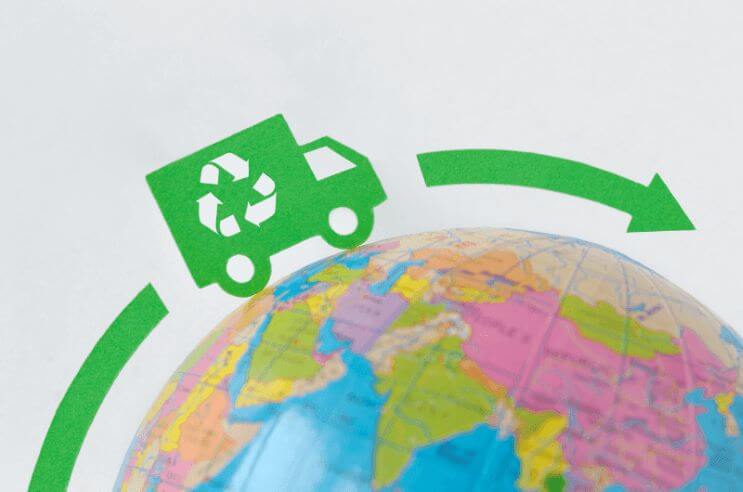Making Logistics Green: The 5 Most Ecological Modes of Transport
Ecology and sustainability are the new black so companies strive to be greener, whether through their own initiative, due to regulations like the Paris Agreement, or ISO 14001. Read on to find out what the greenest methods for transporting goods are.

Source: www.canva.com
The sustainability of companies does not hinge solely on ecological transport. There are other ways to be greener, such as eco-friendly packaging of products, recycling waste in the manufacturing process, utilizing environmentally friendly technologies, and more. However, given the current growing trend of e-commerce (which is expected to make up 41% of all retail purchases by 2027 (bcg.com, 2023)), it is important for companies to focus on reducing their carbon footprint by utilizing a variety of eco-friendly methods to transport their goods.
How Do We Stand in Terms of Global CO2 Emissions?
Global carbon dioxide emissions from fossil fuels and industries increase annually. In 2022, global CO₂ reached 37.15 billion metric tons and were expected to rise by 1.1% in 2023, reaching a record high of 37.55 of CO₂. Since 1990, global CO2 emissions have increased by over 60% (statista.com, 2022).
For a better understanding, the average passenger car emits approximately 4.6 metric tons of CO₂ per year (epa.gov, 2023), which means that approximately 8.08 billion cars would collectively emit 37.15 billion metric tons of CO₂ in one year.
It should probably be no surprise when we tell you that the largest carbon dioxide emitter is China (CO2 emissions in China have increased by more than 400% since 1990), followed by the United States (statista.com, 2022).

Source: www.canva.com
Freight Transportation Accounts for Approximately 8% of Global Greenhouse Gas Emissions
Aircraft, ships, trains, and trucks transport billions of tons of freight every year. In the year 2022, these modes of transport moved 140 trillion tonne-kilometers of freight. A tonne-kilometer is the standard unit of measurement used in transportation logistics to express the total weight of cargo (in metric tons) moved over a one-kilometer distance. How many tonne-kilometers does each mode of transport move and how much CO2 emissions do they generate (climate.mid.edu, 2023)?
- Air freight: In 2020, 303 billion tonne-kilometers were shipped, resulting in an estimated 155 million tons of CO2 emissions.
- Rail freight: Shipped 10,842 billion tonne-kilometers with 170 million tons of CO2 emissions produced in 2020.
- Road freight: Emitted more than 2,230 million tons of CO2 and transported 26,807 billion tonne-kilometers in 2020.
- Sea freight: Moved 101,486 billion tonne-kilometers in 2020 and emitted 657 million tons of CO2.
From the statistics, it is clear that when considering the amount of goods transported and the amount of CO2 produced, sea transportation emerges as the most efficient and most ecological mode of transport, followed by rail transportation. Furthermore, when comparing truck vs. rail transportation, road freight can emit more than 5 times more CO2 than rail freight when transporting the same amount of cargo over the same distance.
What Are the Most Ecological Modes of Transport?
We are not talking about individual people here because if we were, we would definitely mention carpooling, public transport, and others as eco-friendly transportation options. However, we are mainly talking about companies that transport materials for production or distribute the finished products.
What greener choices can companies make in terms of transporting their goods?

Source: www.canva.com
1. Maritime Transport
If we consider the statistics above, maritime transportation is the most fuel-efficient freight transportation mode. As you can see from the data below, inland barges are at the very top.
Tip: Read about the 4 new trends in maritime logistics, including the expansion of the green and blue economy.
When it comes to fuel efficiency, according to the U.S. Department of Transportation, nothing compares to inland barges. A single gallon of fuel can propel an inland barge 514 miles with a ton of cargo. When we compare it to the second most eco-friendly mode of transportation – rail transport, we find that it is less than half as effective as an inland barge and can travel 202 miles in a single gallon.

Source: www.canva.com
2. Freight Trains
Trains provide one of the most ecological ways of transporting goods over land. Compared to trucks, trains are particularly effective in transporting bulky items such as coal, grain, and other raw materials because they can carry much heavier loads than trucks. Trucks only achieve 145 ton-miles per gallon of fuel, compared to trains, which achieve 477 ton-miles per gallon (Sam Forman, Stanford University, 2022). This results in not only lower CO2 emissions but also in cost savings.
Have you ever heard of Genset locomotives? Traditional locomotives use one large diesel engine that runs continuously regardless of the terrain or load during transportation. In contrast, Genset locomotives use three smaller diesel engines that engage as needed. This means that when lower power is required, only one engine is activated, which leads to lower emissions. According to research, genset locomotives can save up to 40% in fuel compared to traditional diesel locomotives and reduce CO₂ emissions by up to 40% (International Institute of Noise Control Engineering, 2017).
Tip: Read about the evolution and influence of rail transportation on global logistics.

Source: www.canva.com
3. Alternative Fuel Trucks
Alternative fuels are those derived from sources other than petroleum. One of their main advantages is that they produce fewer emissions than gasoline or diesel. Examples of alternative fuels:
- Hydrotreated vegetable oil (HVO): A second-generation biofuel that is made from a wide range of materials with added hydrogen.
- Electrofuel: Created from carbon dioxide and water using electrolysis and other chemical reactions that are fueled by renewable energy sources.
- Hydrogen: Vehicles powered by pure hydrogen produce no harmful emissions.
- Biodiesel: Alternative fuel made mainly from vegetable oils. The main difference between biodiesel and HVO is the production process. Biodiesel is produced through a process called transesterification where vegetable oils are mixed with alcohol. HVO is produced through hydrotreatment which is a process where vegetable oils are hydrogenated, removing oxygen and other impurities. Using biodiesel can reduce CO2 emissions by up to 30-70%, depending on the type of material used to produce biodiesel (volvotrucks.cz).
- And others.

Source: www.canva.com
4. Hybrid and Electric Trucks
Electric cars are powered by electricity which means they do not produce emissions during operation. In contrast, hybrid freight vehicles combine a diesel or gasoline engine with an electric motor. Both options contribute to improving sustainability in the transportation sector. Driving an electric car emits 17–30% less carbon dioxide per mile than a gasoline or diesel vehicle, according to research published in 2018 by the European Energy Agency.
According to the international research organization BloombergNEF, electric vehicles will constitute 32% of medium and heavy-duty commercial sales by 2050. For comparison, in 2023 only 0.1% of trucks on EU roads have a zero-emission powertrain (acea.auto, 2023). How are big delivery companies doing in terms of electric cars?
- DHL currently has more than 29,200 EVs worldwide and aims to have EVs handle 60% of our pick-ups and deliveries in 2030 (dhl.com).
- The UPS fleet includes more than 18,300 vehicles powered by alternative fuels and advanced technologies, including over 1,000 electric and plug-in hybrid electric vehicles on the road. By 2050, they aim to achieve complete carbon neutrality (about.ups.com).
- USPS wants to have 66,000 electric vehicles on the road by 2028. Currently, they have around 21,000 electric vehicles.
Are you interested in more information? We wrote an article about how big logistics companies are striving for a better environment.

Source: www.canva.com
5. Cycling & Walking
When we aren’t talking about international transport or the distribution of bulky goods, then cycling, walking, or riding electric scooters are excellent ecological alternatives. These modes of transportation can be particularly used for last-mile delivery in cities.
For example, cycling is not only a more environmentally friendly option but can also be faster and more efficient than cars, especially in densely populated areas.
Together for a Greener Future
Do you know how you can ensure that your transportation is more environmentally friendly and produces less CO2 emissions? By avoiding the transportation of air. You can easily achieve this with the container and truck loading software EasyCargo. In the application, you can plan your shipment virtually to maximize space utilization. It will help you save time, space, and money. Try our 10-day free trial and discover all of the features of EasyCargo.




